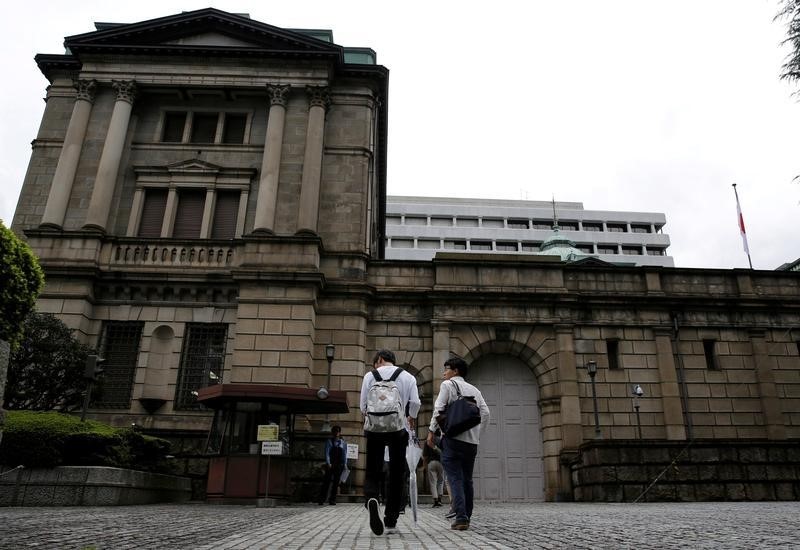(Bloomberg) -- Trillions of yen of financial support hasn’t been enough to win over Japan’s commercial banks, with the majority of lenders still vehemently opposed to the central bank’s negative interest rate policy.
While the Bank of Japan’s 75 trillion yen ($700 billion) of measures to prop up lending during the pandemic are welcome help, senior banking sector officials interviewed by Bloomberg said the prevailing view in the industry remains that the profit-draining negative rate should never be lowered and should be scrapped altogether.
The comments suggest that even in the middle of an economic crisis, the hurdle for the BOJ to make greater use of its interest rate policy remains extremely high, with other central banks around the world also feeling reluctant to lower or experiment with negative rates.
The BOJ next meets on June 15-16 and is not expected to lower the 0.1% rate or take any new measures. In response to the virus so far, the bank has pledged unlimited purchases of government bonds, expanded its exchange-traded fund buying and launched two interest-free lending programs.
Most Economists See No Major Action From BOJ in June: Survey
For the country’s commercial banks, the BOJ’s sub-zero rates strategy aimed at stimulating the economy and prices has eroded their profit margins. That’s created a frosty relationship between policy makers and banking executives who think the low rates are doing more harm than good.
Kanetsugu Mike, who represents the 117 banks of the Japanese Bankers Association, has raised the issue of squeezed margins, largely following the line of previous chairmen of the industry group.
“The profit environment of not only banks but all financial institutions has become severe as interest rates fell and the yield curve flattened,” Mike, who is also chief executive of MUFG Bank, said at his inaugural press conference in April.
Between the years ended March 2016 and March 2019, domestic net interest income at the association’s banks fell to 5.9 trillion yen from 6.4 trillion yen. The average net interest margin, a gauge of lending profitability, has narrowed to 1.08% among among lenders on the Topix Banks Index, from 1.23% when the negative rate policy was introduced in 2016.
Welcome Help
The central bank deserves high marks for its actions since March to alleviate market tensions through the provision of liquidity, especially its dollar supplying, said a senior executive at one of Japan’s biggest three banks, echoing comments by two other megabank executives.But the central bank also had an obligation to do this because its negative rate policy forced banks to look abroad for business, heightening their need for dollar supplies, the executive added.
For smaller regional banks, the central bank’s lending programs have been of greater importance than its dollar provision, helping them supply funds to keep companies afloat as the pandemic hammers the economy.
The BOJ conducted hearings with banks and tailored the program to their needs, said a senior regional bank official. In particular, the banks applauded the decision to pay 0.1% interest on reserves at the BOJ matching the amount banks lent out from their free BOJ loans, the official added.
Still, the three megabank executives and three regional bank officials Bloomberg spoke to all said the BOJ should end the negative rate policy.
Despite the ongoing resistance within the banking community to the policy, the central bank insists that a rate cut remains a live option.
BOJ Governor Haruhiko Kuroda said in May that lowering the negative rate still wasn’t necessary at that time. But with the economy expected to suffer its biggest contraction in more than six decades this quarter, the central bank may need to take more action in the coming months.The BOJ is aware of the side effects piling up from its prolonged low interest-rate regime. At the same time, BOJ officials aren’t sure if raising rates to zero or above would even help banks if that resulted in the economy tanking more, the yen strengthening and stocks tumbling, according to people familiar with the matter.
Economists surveyed by Bloomberg in June said it would take an export-damaging yen move beyond 98 against the dollar to prompt the BOJ to lower the rate. The dollar was changing hands at around 107 yen on Thursday afternoon, some distance from that level.
Some economists say the greater use of negative rates abroad might be the only likely factor that would force the BOJ to go lower.Either way, the BOJ’s loan programs haven’t budged the viewpoint in commercial bank boardrooms, the banking officials said.
The virus loan assistance and the negative rate need to be looked at separately, said another of the regional bank officials. The loan help doesn’t simply give the BOJ free rein to do whatever it likes with negative rates, the official said.
©2020 Bloomberg L.P.
